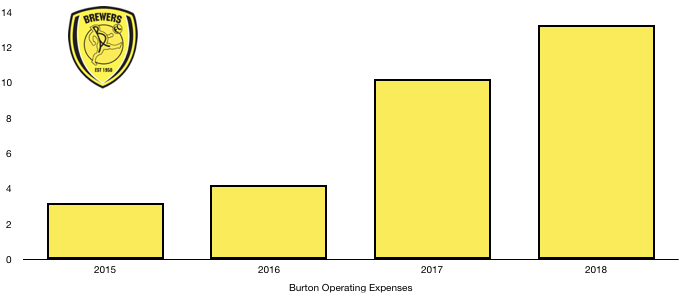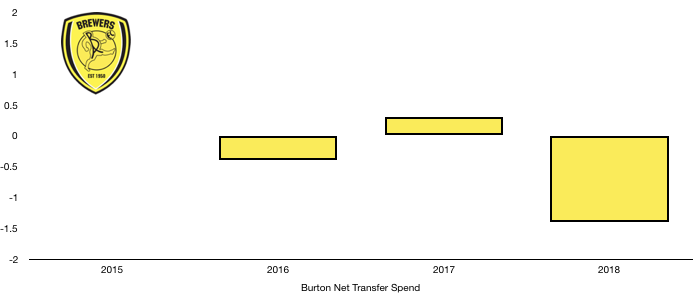Burton suffered from second-season syndrome after being unable to upset the odds again and survive for a second season in a row in the Championship, finishing 23rd.
It was always going to be an uphill struggle due to their shoestring budget, however they fought valiantly and were narrowly relegated by 2 points.
Burton didn’t fare much better in the cups but did enjoy a lucrative tie in the EFL Cup at Old Trafford, ending in a 4-1 defeat to Manchester United. Burton were also eliminated from the FA Cup in the Third Round.
Relegation and rising costs saw profits fall from £1.2m to £0.4m (67%), which is still more than the majority of Championship clubs who run themselves a lot less sensibly (financially).
Let’s delve into the numbers.

Revenue Analysis

Burton’s second season in the Championship ending in relegation didn’t stop revenue from rising, increasing from £11.4m to £12.9m (13%).
Matchday revenue rose from £1.5m to £1.8m (20%) despite average attendances falling from 5,227 to 4,645 (13%) due to lucrative cup ties and increased ticket prices. A sensational run to the EFL Cup Semi-Finals should boost matchday revenue once again.
Broadcasting & Commercial revenue rose from £9.9m to £11.1m (12%) on the back of increased EFL Championship distributions despite a lower finish and the lucrative tie with Manchester United in the EFL Cup.
Commercial revenue also benefited from a second successive year in the Championship.
Looking ahead, Burton were unable to bounce straight back to the Championship and revenue will be hit significantly as a result.
The lower prize money in League One will see broadcasting revenue fall significantly. This will however be offset slightly by their EFL Cup run.
Revenue will however take a beating and will fall by around half to £5-6m most likely.
Costs Analysis

Burton saw costs grow at a faster rate than revenue, hurting profitability. Costs rose from £10.2m to £13.3m (30%) as the increased costs of remaining competitive in the Championship continues to rise.
Amortisation increased from £350k to £475k (36%) which is still very low for a Championship club. The rise was largely due to an increase in transfer spending, with Burton not spending transfer fees for a while prior to promotion ahead of the 2016/17 season.
Burton had a net interest income of £1.7m, a huge change from the net interest expense of £0.2m in 2017. What this interest income relates to is unhelpfully not disclosed and is likely to relate to transfer fee interest receivable on instalments (unlikely due to the lack of previous transfers) or loans to their owner (although this should have been disclosed in the accounts).
Burton paid tax of £105k on their profit before tax of £500k, an effective tax rate of 20%, in line with the corporate tax rate of 19%.

Burton saw wages rise to record levels, breaking the £10m barrier as wages increased from £7.7m to £10.0m (30%) as players were rewarded with bonuses and new contracts on the back of survival last season and new signings commanded higher wages.
This wage rise works out at a measly extra £44k a week, showcasing the tight budgetary controls Burton work under, showing what an achievement it was to even survive last year!
Directors of the club were paid £63k, having received no renumeration in 2017.
Looking ahead, costs will fall out of necessity after relegation as key players leave and relegation wage drop clauses come into effect. With revenue likely to halve, Burton will be hoping costs go someway to covering that, although it is almost certain Burton will make a loss of at least a couple of million in 2019.
Transfers Analysis

Burton are a club of modest means, working tirelessly and above expectations on a small budget and 2018 was no different as the club spent a tiny £0.5m on one player, which was all recouped and then some by one sale.
In came Liam Boyce for £0.5m and out went Jackson Irvine for £1.9m, a net transfer income of £1.4m after a net transfer spend of £0.3m in 2017.
Liam Boyce proved a decent signing, chipping in with some crucial goals in their relegation battle although Irvine was missed throughout the season.
The sale of Irvine netted Burton a profit on his sale of £0.8m, a vital amount in keeping Burton in a profitable position.
In cash terms, Burton spent £1.1m (of which much relates to prior periods) and received £1.3m (further cash will be due although not disclosed in the accounts), a net cash inflow of £0.2m.
The sale of Irvine helped Burton record a profit and with no such sales in 2019, Burton are set to make a loss before taking into account the fall in revenue due to relegation.
Debt Analysis

Burton saw cash levels completely depleted after a difficult season, falling into their overdraft as cash of £0.8m was wiped out.
The cash was used to fund their loss (before taking into account transfers) and to pay for improvements to the club’s infrastructure of £0.5m (although this was down from £1.3m in 2017).
Debt levels remained at £0.1m, being their overdraft facility. Their owner has run the club debt-free, placing no loan burden on Burton as the club continue to live within their means.
This is a noble practice but makes future growth difficult without further investment and with rising costs, remaining profitable in the Championship, let alone League One, is become more onerous by the season.
Burton fans will be hoping for at least some injection of funds going forward to push back into the Championship and hopefully stay for a while this time. Without it, Burton risk a prolonged and unprofitable stay in League One for some time.
Thanks for reading – Share with a fan!

